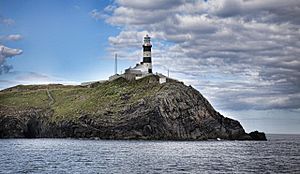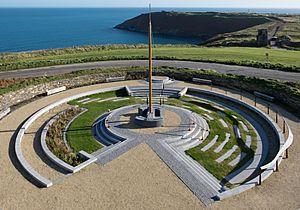Old Head of Kinsale facts for kids
Quick facts for kids Old Head of Kinsale |
|
|---|---|
| Native name Irish: An Seancheann |
|

Lighthouse on the Old Head
|
|
| Type | Castle, golf course, lighthouse |
| Lua error in Module:Location_map at line 420: attempt to index field 'wikibase' (a nil value). | |
The Old Head of Kinsale (called An Seancheann in Irish) is a famous piece of land that sticks out into the sea. It is located near Kinsale in County Cork, Ireland.
People have built castles on this headland since at least the 200s AD. The castle you see today was built in 1223. An early lighthouse was also built here in the 1600s. The Old Head is the closest land (about 18 kilometers or 11 miles) to where the RMS Lusitania ship sank in 1915. Today, you can only visit the Old Head if you are playing at the private golf course there. This has caused some debate.
Contents
How the Old Head Was Formed
The Old Head of Kinsale was shaped by how different rocks wear away. Imagine a sandwich with a hard layer in the middle and two softer layers on the outside. The Old Head is like that. It has a strong layer of sandstone between two softer layers of shale rock.
The sea wears away the softer shale much faster than the hard sandstone. Over a very long time, this process made the strong sandstone stick out into the sea, forming the headland we see today.
The Old Head Castle
The Old Head Castle is made up of a long wall with several towers. This wall blocks off the headland from the rest of the land. People believe it was built around 200 AD by an Irish leader named Cearmna. It was first called Dún Cearmna, which means "Cearmna's fort."
Later, in the 1100s, King Henry II gave the land to a man named Milo de Cogan. After Milo de Cogan died, his son Richard took over. Richard's daughter then married Milo de Courcy. Milo de Courcy built a new castle around 1223. Because of this, the castle is sometimes called De Courcy Castle.
In the 1500s, Owen MacCarthy took control of the castle from the de Courcy family. However, the English took the castle back in 1600. This happened just before the Spanish tried to invade Kinsale during the Siege of Kinsale.
The Old Head Lighthouse
A lighthouse is a tower with a bright light that helps guide ships at sea. On November 13, 1665, King Charles II gave permission to Sir Robert Reading to build six lighthouses around Ireland. One of these was built on the Old Head of Kinsale.
This first lighthouse was a metal basket (called a brazier) with a fire in it, placed on the roof of a small house. There might have been earlier fires to guide ships, but this was the first proper building for a lighthouse here. After 1683, the light was stopped for a while.
In 1804, a temporary light was set up with oil lamps. Eight years later, people decided a stronger, permanent lighthouse was needed. A new tower lighthouse opened on May 16, 1814. However, this tower was too high (about 90 meters or 294 feet above the water) and was often hidden by clouds.
So, a new lighthouse was built lower down, right at the tip of the Old Head. Construction started in 1850 and finished three years later. This new light first shone on October 1, 1853. Over the years, the lighthouse was updated. In 1907, a new lamp was installed. In 1972, the oil lamp was replaced with electricity. The lighthouse became automatic in 1987, meaning it could run without people always being there.
The RMS Lusitania
On May 7, 1915, the RMS Lusitania was a large passenger ship sailing from New York to Liverpool. A German U-Boat (submarine) fired a torpedo at it about 18 kilometers (11 miles) from the Old Head of Kinsale. The ship sank in just 18 minutes. Sadly, 1,198 of the 1,959 people on board died. The bodies were later taken to Queenstown.
In 2015, a museum opened at the signal tower of the Old Head lighthouse. This was to remember the 100th anniversary of the sinking. The person who owns the wreck of the Lusitania lent many items to the museum. These items had been found by a diver named Eoin McGarry four years earlier.
Golf at the Old Head
Today, the Old Head of Kinsale is very popular with golfers. An 18-hole golf course opened there in 1997. The course is special because you can see the ocean from every single hole.
Since the golf course opened, only golfers and their guests can go to the Old Head of Kinsale. This has led to a long campaign by a group called the "Free the Old Head of Kinsale Campaign." They want the public to be able to visit the headland again. They often hold "People's Picnics," sometimes even going onto the headland to have their picnics near the Old Head lighthouse.
See also
 In Spanish: Cabo de Old Head of Kinsale para niños
In Spanish: Cabo de Old Head of Kinsale para niños




